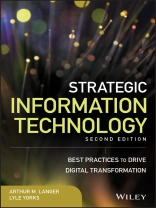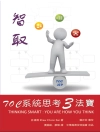Successfully navigate the changing face of the CIO role
Strategic Information Technology offers CIOs a handbook for engaging with the senior management conversations surrounding strategy. The CIO role is currently undergoing a massive transition from technology-focused expert to a more strategic mindset, and this book provides proven methods for taking your seat at the table. Lessons from high-performing CIOs and a wealth of leading-edge insight provide invaluable guidance for positioning technology as a strategic driver across the business, while a focus on building the necessary connections—for example, an alliance between IT and HR—provide a multimodal approach to navigating the transition.
The evolution of the CIO’s role involves more than simply technical knowledge; the new CIO must be an influencer, an engager, and just as adept at the soft skills that become increasingly crucial as you climb the management ladder. It’s about changing mindsets, translating hard skills into strategic advantages, and demonstrating IT’s value to the strategic decision making process. This book provides best practices, illustrative examples, and up-to-date perspective for CIOs wanting to:
- Position IT as a critical driver of overall strategy
- Build on functional expertise with strategic insight
- Learn from the stories of successful tech-to-strategy transformations
- Engage C-Suite peers in shaping the strategic conversation
Not long ago, the CIO occupied a unique place in the C-Suite. Executive by title, CIOs have nevertheless been seen as predominantly the “chief tech expert” with little input into strategy, as IT has historically been regarded as a tool rather than a source of competitive advantage. The truth is becoming increasingly apparent, with companies around the world turning to technology in order to gain a competitive edge, and CIOs are beginning to claim their place in strategy discussions. Strategic Information Technology offers much needed guidance for a successful transformation.
Table of Content
Foreword xi
Preface xiii
Acknowledgments xix
CHAPTER 1 The CIO Dilemma 1
Business Integration 2
Security 2
Data Analytics 3
Legal Exposure 3
Cost Containment 3
Some History 4
The Challenge 5
The New Paradigm 6
Consumerization of Technology: The Next Paradigm Shift 7
The End of Planning 8
The CIO in the Organizational Context 9
IT: A View from the CEO 14
CHAPTER 2 IT Drivers and Supporters 19
Drivers and Supporters 19
Drivers: A Closer Look from the CIO 23
Supporters: Managing with Efficiency 23
IT: A Driver or a Supporter? 24
Technological Dynamism 25
Responsive Organizational Dynamism 26
IT Organization Communications with ‘‘Others’’ 31
Movement of Traditional IT Staff 31
Technology Business Cycle 33
Information Technology Roles and Responsibilities 38
Conclusion 39
CHAPTER 3 The Strategic Advocacy Mindset 41
What Is Strategic Advocacy? 41
A Political Economy Framework for Contextualizing Strategic Advocacy 44
Strategic Thinking: A Particular Kind of Mindset 47
Political Savvy as the Underpinning of Effective Strategic Advocacy 56
Conclusion 62
CHAPTER 4 Real-World Case Studies 67
BP: Dana Deasy, Global CIO 68
Merck & Co.: Chris Scalet, Senior Vice President and CIO 70
Covance: John Repko, CIO 71
Cushman & Wakefield: Craig Cuyar, CIO 73
Prudential: Barbara Koster, SVP and CIO 75
Procter & Gamble: Filippo Passerini, Group President and CIO 76
Cushman & Wakefield: A View from Another Perspective 77
Conclusion 83
CHAPTER 5 Patterns of a Strategically Effective CIO 87
Personal Attributes 87
Organization Philosophy 100
Conclusion 114
CHAPTER 6 Lessons Learned and Best Practices 117
Five Pillars to CIO Success—Lessons Learned 117
The CIO or Chief IT Executive 120
Chief Executive Officer 134
Middle Management 145
Conclusion 150
CHAPTER 7 Implications for Personal Development 159
Rationale for a Self-Directed Learning Process of Personal Development 160
Adopting a Developmental Action Inquiry Process for Both Strategic Insight and Mindset Awareness 162
Testing One’s ‘‘Business‘‘ Acumen 165
Thinking Holistically in Terms of Situational Analysis and Synthesis of the Organization’s Position 167
Developing Strategic Mindsets Within the Technology Function 171
The Balanced Scorecard 172
Conclusion 176
CHAPTER 8 Digital Transformation and Business Strategy 179
Introduction 179
Requirements Without User Input 184
The S-Curve and Digital Transformation 187
Organizational Change and the S-Curve 189
Communities of Practice 190
The Technology Leader Role in the Digital Era 190
Technology Disruption on Firms and Industries 191
Critical Components of ‘‘Digital‘‘ Organization 193
How to Assimilate Digital Technology 194
Conclusion 196
CHAPTER 9 Integrating Gen Y Talent 197
Introduction 197
Employment in the Digital Economy 199
Attributes of Gen Y Employees 200
Benefits of Gen Y Employees 201
Integration of Gen Y with Baby Boomers and Gen X 201
Designing the Digital Enterprise 202
Gen Y Talent from Underserved Populations 203
Langer Workforce Maturity Arc 204
Implications for New Pathways for Digital Talent 210
Global Implications for Sources of Talent 212
Conclusion 212
CHAPTER 10 Creating a Cyber Security Culture 215
Introduction 215
History 215
Presenting to the Board 217
Designing a Cyber Security Culture 217
Dealing with Compromise 218
Cyber Security and Responsive Organizational Dynamism 218
Cyber Strategic Integration 219
Cyber Cultural Assimilation 220
Summary 221
Organizational Learning and Cyber-Minded Application Development 222
Risk and Cyber Security 222
Risk Responsibility 223
Cyber and Driver/Supporter Theory 225
CHAPTER 11 The Non-IT CIO of the Future 227
Driver-Side Responsibilities—New Automation 227
Conclusion 242
CHAPTER 12 Conclusion: New Directions for the CIO of the Future 245
Bibliography 261
About the authors 267
Index 269
About the author
ARTHUR M. LANGER, Ed D, is the Professor of Professional Practice, Director for the Center for Technology Management, and the Academic Director of the Master of Science Programs in Technology Management at Columbia University. He is also an affiliated faculty member in the Department of Organization and Leadership at the Graduate School of Education (Teachers College).
LYLE YORKS, Ed D, is Professor in the Department of Organization and Leadership, Teachers College, Columbia University, where he teaches courses in strategy development as learning process, strategic human resource development, strategic information technology and research.












